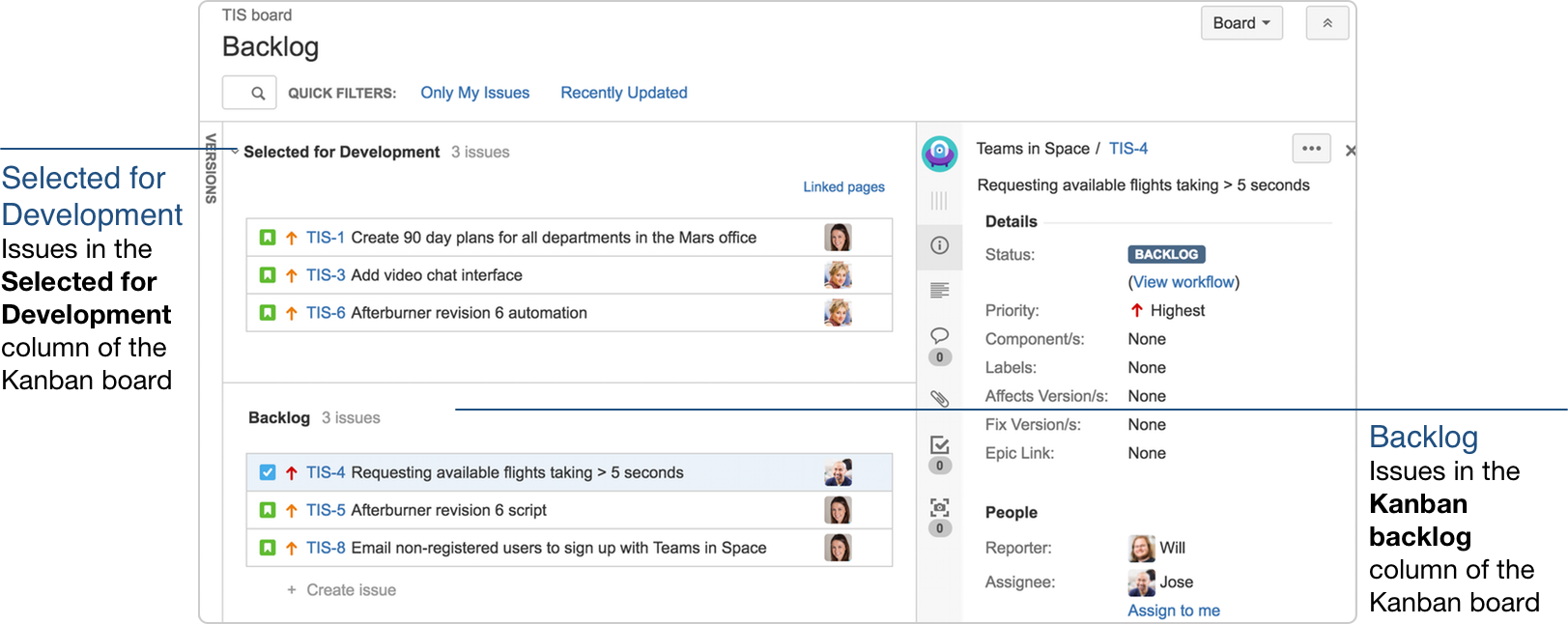Using your Kanban backlog
About the Kanban backlog
Managing your backlog in the first column of your Kanban board is easy to do — as long as there are only a few issues in your backlog. As your backlog grows, viewing and scrolling through these issues can become difficult.
If you're planning work for your team, you get a bigger backlog that gives you an optimized list view of the issues you're creating and ranking for your team. If you're a team member working on a Kanban project, you can focus on your work-in-progress on the Kanban board, without the distraction of items in planning.
Accessing the Kanban backlog
Screenshot: sample Kanban backlog (with an issue selected), with Backlog and Selected for Development as board columns
Note in the screenshot above, the Kanban backlog shows issues in both Backlog and Selected for Development sections. This makes it easy for you to move issues from the backlog to selected for development. Issues selected for development will then appear in your Kanban board, and your team can start working on them accordingly.
An issue will only be visible in the Kanban backlog if:
- the issue matches the board's saved filter, and
- the issue's status maps to the Kanban backlog column and the next column on the Kanban board.
This means that if you have the columns Selected for Development, In Progress, and Done on your Kanban board, ensure that you have a status mapped to In Progress at least. If you map all the statuses to the first column (Selected for Development), you won't see any issues in the Backlog section of the Kanban backlog. You will only see issues in the Selected for Development section.
What can I do in the Kanban backlog?
| Task | Instructions |
|---|---|
| Add issues to the backlog | Click Create in the header to open the 'Create Issue' dialog and create your issue. The issue will be added to the backlog under the currently selected issue, or at the top of the backlog if no issue is selected. Tips:
|
| Prioritize the backlog | Drag and drop an issue to rank it. You can also right-click the issue to open a menu that allows you to send it to the top or the bottom of the backlog. |
| View and edit an issue's details | Click the desired issue on the board. The issue's details will display in the issue detail view, where you can also edit some issue details, depending on the issue detail view configuration. If you want to select an issue, rather than open the issue's details, use ctrl-left click or command-left click. |
| Create sub-tasks | Select the desired issue, press the '.' key, and type 'create sub-task' to open the 'Create Sub-task' dialog. Create the sub-task as desired. Sub-tasks are useful for breaking a story (issue) down into implementable chunks. Note that in the Kanban backlog:
|
| Transition an issue | Drag and drop an issue from the Backlog section to the Selected for Development section (or the next column of your Kanban board), to move the issue from the backlog to the next status in your workflow. Note, the Selected for Development section may be named differently, depending on the column configuration of your Kanban board. |
| Flag an issue | Right-click an issue and select Add flag. You can also add a comment with your flag, perhaps to indicate your reason for adding the flag. |
| Delete an issue | Right-click an issue and select Delete. |
| Find issues | Create your own Quick Filters to view only the issues you want. See Configuring Quick Filters for details. Search for an issue by name, code, or assignee. |
| Organize stories into epics | Click EPICS (aligned vertically, left side of the board) to show the 'EPICS' panel. You can create epics, drag and drop issues into epics, and filter by epics via this panel. An epic is essentially a large user story, used for grouping smaller stories. For example, you may have a 'Quarterly audit' theme for your release, which you could capture as an epic. Note, you need to enable the Epics panel for your board for this panel to display. |
| Plan versions | Click VERSIONS (aligned vertically, left side of the board) to show the 'VERSIONS' panel. You can create and edit versions, assign issues to versions via drag-and-drop, and filter by versions via this panel. |
| Select issues for your team to work on | After grooming the issues in your backlog, you can select which issues your team will start working on, by dragging and dropping issues from the Backlog section to the Selected for Development section. Issues selected for development will then appear in your Kanban board, and your team can start working on them accordingly. Note that you can move a sub-task from the Backlog to Selected for Development independently of its parent, and vice versa. |
Next steps
Need help? If you can't find the answer you need in our documentation, we have other resources available to help you. See Getting help.
Read the following related topics:

